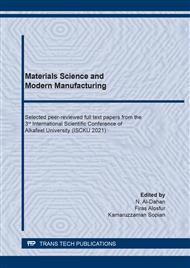[1]
S.Palanichamya, J.Raj Mohamedb, K.Deva, Kumarc, P.S. Satheesh Kumara, S.Pandiarajand, L.Amalraj, Physical properties of rare earth metal (Gd3+) doped SnO2 thin films prepared by simplified spray pyrolysis technique using nebulizer.,, Optik, Vol. 194, (2019): p.162887.
DOI: 10.1016/j.ijleo.2019.05.093
Google Scholar
[2]
Zhan, Zili,;Wang, Wei-Ning1; Zhu, Liying; An, Woo-Jin; and Biswas, Pratim, Morphology control of SnO2 thin film gas sensors by a flame aerosol reactor (2010).
Google Scholar
[3]
Yousif, Salam Amir, and Jenan Mohamed Abass. Structural, Morphological and Optical Characterization of SnO2: F thin films prepared by Chemical spray Pyrolysis., International Letters of Chemistry, Physics and Astronomy, Vol. 13, (2013):p.pp.90-102.
DOI: 10.18052/www.scipress.com/ilcpa.18.90
Google Scholar
[4]
H.M. Yatesa1, P. Evansa, D.W. Sheela, b, The influence of F-doping in SnO2 thin films, Physias Procedia, vol. 46, (2013) , p.pp.159-166.
Google Scholar
[5]
Yousif, Salam Amir, and Jenan Mohamed Abass. Structural, Morphological and Optical Characterization of SnO2: F thin films prepared by Chemical spray Pyrolysis., International Letters of Chemistry, Physics and Astronomy, vol 13, (2013), p.pp.90-102.
DOI: 10.18052/www.scipress.com/ilcpa.18.90
Google Scholar
[6]
C. Jariwala1, M. Dhivya1, R. Rane1, N. Chauhan, P.A. Rayjada, P.M. Raole, P.I. John Preparation and Characterization of Antimony Doped Tin Oxide Thin Films Synthesized by Co-Evaporation of Sn and Sb using Plasma Assisted Thermal Evaporation., Journal of nano –and electronic physics, Vol 5, No.3 (2013), p.02029.
Google Scholar
[7]
Tang-Yu Lai, Te-Hua Fang, Yu-Jen Hsiao, Ching-An Chan, Characteristics of Au-doped SnO2–ZnO heteronanostructures for gas sensing applications., Vacuum, Vol.166, (2019): p.pp.155-161.
DOI: 10.1016/j.vacuum.2019.04.061
Google Scholar
[8]
Dilip L.Kambleab, Namdev S.Haralec, Vithoba L.Patilc, Pramod S.Patilc, Laxman D.Kadam , Characterization and NO2 gas sensing properties of spray pyrolyzed SnO2 thin films., Journal of Analytical and Applied Pyrolysis, Vol. 127, (2017):p.pp.38-46.
DOI: 10.1016/j.jaap.2017.09.004
Google Scholar
[9]
Maziarz, Wojciech. TiO2/SnO2 and TiO2/CuO thin film nano-heterostructures as gas sensors., Applied Surface Science, Vol.480, (2019): p.pp.361-370.
DOI: 10.1016/j.apsusc.2019.02.139
Google Scholar
[10]
Eva Lacknera, Johanna Krainera, Robert Wimmer-Teubenbachera, Florentyna Sosadaa, Marco Delucaa, Christian Gspanb, Karl Rohracherc, Ewald Wachmannc, AntonKöck,Carbon monoxide detection with CMOS integrated thin film SnO2 gas sensor., Materials Today: Proceedings, Vol. 4. Part.2, (2017): p.pp.7128-7131.
DOI: 10.1016/j.matpr.2017.08.007
Google Scholar
[11]
Sharma, Bharat, and Jae-ha Myung. Enhanced nitrogen dioxide sensing properties of Ni4Cr1/SnO2 heterostructures., Ceramics International, Vol. 46, No.11, (2020).
DOI: 10.1016/j.ceramint.2020.04.271
Google Scholar
[12]
Aminuddin Debatarajaab, Dary Widia Zulhendria, Brian Yuliartoad, Nugrahaad Hiskiac, Bambang Sunendar, Investigation of nano- structured SnO2 synthesized with polyol technique for CO gas sensor applications., Procedia engineering,Vol. 170, (2017): p.pp.60-64.
DOI: 10.1016/j.proeng.2017.03.011
Google Scholar
[13]
Alexandra Tischner, Thomas Maier, Christoph Stepper, A. Köck, Ultrathin SnO2 gas sensors fabricated by spray pyrolysis for the detection of humidity and carbon monoxide., Sensors and Actuators B: Chemical, Vol.134, No.2, (2008): p.pp.796-802.
DOI: 10.1016/j.snb.2008.06.032
Google Scholar
[14]
Boshta, M., F. A. Mahmoud, and M. H. Sayed. Characterization of sprayed SnO2: Pd thin films for gas sensing applications., Journal of Ovonic Research, Vol. 6, No.2, (2010): p.pp.93-98.
Google Scholar
[15]
Giselle Jime´nez-Cadena, Jordi Riu, F. Xavier Rius, Gas sensors based on nanostructured materials, The Royal Society of Chemistry, Vol 132, 2007, p.p.1083–1099.
DOI: 10.1039/b704562j
Google Scholar
[16]
Analysis of greenhouse gas emissions trends and projections in Europe 2003,, European Environmental Agency (EEA), Copenhagen, ISBN 92-9167-696-9. (2004).
Google Scholar
[17]
Joint Committee on Powder Diffraction Standards (JCPDS), International Center for Diffraction Data, Swarthmore, card no. 96-900-9083 for SnO2 and card no 96-900-8063 for Sb2O3.
Google Scholar
[18]
Z. Chen, D. Pan, B. Zhao, G. Ding, Z. Jiao, M. Wu, Chan-Hung Shek, Law-rence C. M. Wu, and Joseph K. L. Lai, Insight on fractal assessment strate-gies for tin dioxide thin films, American Chemical Society, ACSNANO, Vol. 4, No. 2, (2010): p.1202 – 1208.
DOI: 10.1021/nn901635f
Google Scholar
[19]
Joint Committee on Powder Diffraction Standards (JCPDS), International Center for Diffraction Data, Swarthmore, card no. 36 – 1451, PA, (1980).
Google Scholar
[20]
C. Xu, J. Tamaki, N. Miura, N. Yamazoe, Grain size effects on gas sensitivity of porous SnO2-based elements,,. Sensors and Actuators B: Chemical, Vol.3, (2011),p.pp.147-155.
DOI: 10.1016/0925-4005(91)80207-z
Google Scholar
[21]
S. Palanichamy, L. Amalraj, P. S. Satheesh Kumar." Structural and Optical Properties of SnO2 Thin Film by Nebulizer Spray Pyrolysis Technique, (2016).
Google Scholar
[22]
N. Yamazoe, New approaches for improving semiconductor gas sensors,,Sensors and Actuators B: Chemical, vol.3,(1991), p.pp.7-19.
DOI: 10.1016/0925-4005(91)80213-4
Google Scholar
[23]
M. E. Franke, T. J. Koplin, and U. Simon, Metal and metal oxide nanoparticles in chemiresistors, nanoscale matter, vol. 2, (2006), p.p.36 – 50.
DOI: 10.1002/smll.200500261
Google Scholar
[24]
S. Ilica, Y. Caglar, M. Caglar, B. Demirci., Jornal of optoelectronicsb and advanced materials Vol. 10, No. 10, 2008, p.p: 2592 – 2598.
Google Scholar
[25]
M. Henzler, W. Gopel, Chemical analysis and sensorics with microstructured devices,, Microchimica Acta ,vol. 125, 1997,p.p.179–196.
Google Scholar
[26]
Tian-Tian Li, Long Xia, Hui Yu, Xiao-Xiao Huang, Fabrication of porous tin dioxide with enhanced gas-sensing performance toward NOx, Journal of Materials Science, Issue 26, 55.(17), 2020, p.p.11949–11958.
DOI: 10.1007/s10853-020-04892-0
Google Scholar


